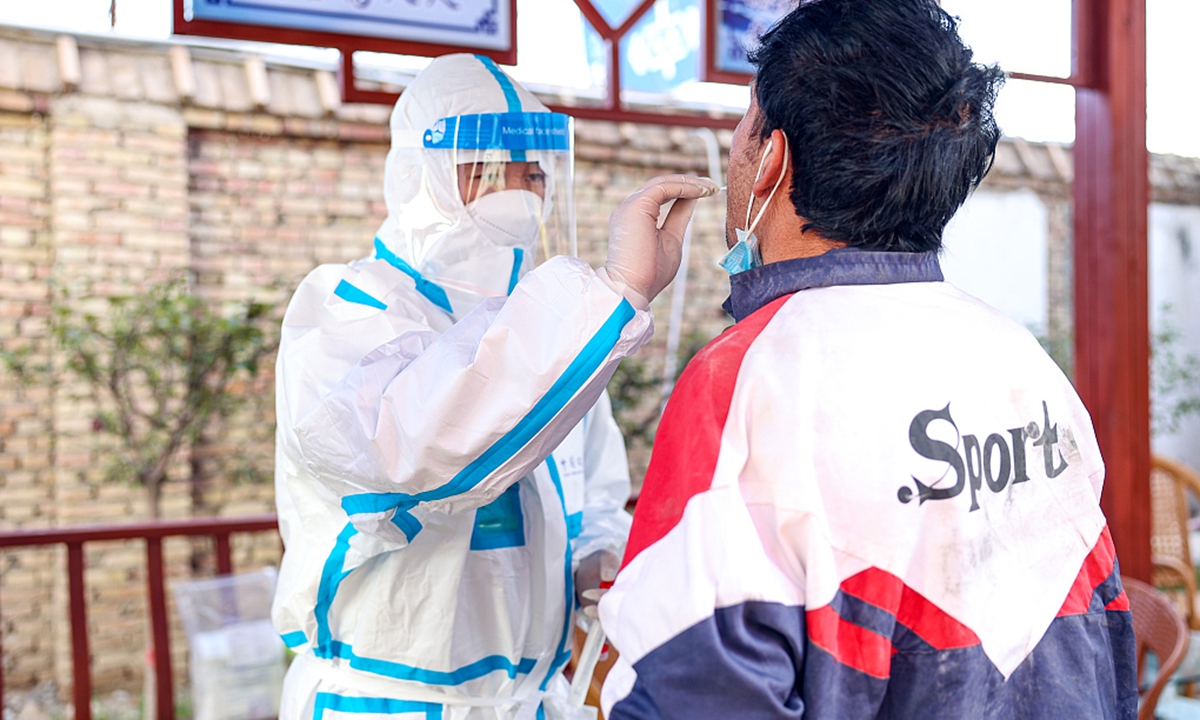Trains leaving Xinjiang suspended as region’s latest epidemic becomes most difficult major public health emergency in local history

Photo: VCG
The latest epidemic outbreak has become the most difficult major public health emergency to prevent and control in local history, during which the nucleic acid testing has become the biggest weakness, said officials in Northwest China's Xinjiang Uygur Autonomous Region as 91 new local asymptomatic cases were recorded on Tuesday, bringing the total to 354 in the region.
The current round of epidemic prevention and control work in Xinjiang has not achieved the goal of "dynamic zero-COVID" for two months not only due to the reasons of strong infectiousness, fast transmission and short incubation period of the Omicron BA.5.2 variant, but also because of some loopholes in the anti-epidemic work, Liu Sushe, vice chairman of the regional government, said at a press conference on Tuesday evening.
The latest epidemic, which broke out on July 30 in Xinjiang, has spread to 37 corps of counties, cities and districts of 13 prefectures, which has become a major public health emergency with the fastest transmission speed, the widest coverage, the largest number of infected people, and the greatest difficulty in prevention and control in the history of Xinjiang, Liu said.
To effectively curb the spillover risk, trains leaving Xinjiang have been suspended. The inter-provincial passenger line and inter-provincial chartered bus business have been suspended; the passenger load factor for flights exiting Xinjiang has been controlled within 75 percent, according to the local authorities at the Tuesday press conference.
By the end of August, the region had effectively controlled the epidemic and achieved initial results. However, due to the mentality of laxity among some people in some areas, the epidemic prevention and control measures have not been fully implemented, which led to the epidemic rebounding in some regions since mid-September, according to the press conference.
Recently, the number of positive cases in regional capital Urumqi, Yining city in the Ili Kazak Autonomous Prefecture, Korla city in the Bayingolin Mongolian Autonomous Prefecture, Gaochang district in Turpan prefecture, and Usu city in Tacheng prefecture, has increased significantly. The rebound of the epidemic in some places is still quite serious, and the anti-epidemic situation in the whole region has become severe and complex, said an official at the press conference.
Loopholes in the epidemic prevention and control work have been exposed during the latest outbreak, Liu pointed out.
The division of high-, middle- and low-risk areas in some parts of the region was not scientific and accurate, and the high-risk areas are too large, which increases the difficulty of management and the risk of transmission, the official explained.
Individual areas sealed off communities that only needed static management while some areas that needed "static management" failed to strictly prevent local residents from leaving their homes, Liu continued.
Also, the governance system and capacity at the grass-roots level were seriously insufficient, and local officials implemented a one-size-fits-all management, making it difficult to effectively implement scientific and accurate epidemic prevention policies in accordance with the law, Liu said.
In particular, nucleic acid testing has become the biggest weakness in autonomous region's prevention and control efforts, Liu stressed.
In the face of a large-scale outbreak of the Omicron BA. 5.2 variant, the ability of nucleic acid testing is insufficient in local epidemic areas, in turn the detection and quarantine of the positive patients failed to keep up with the outbreak transmission, thus making it difficult to cut off the infections in social communities, Liu said.
There is a significant number of nucleic acid sampling personnel who are nonprofessionals, which led to poor sampling, Liu said. Also, some nucleic acid samplers were infected due to improper protection, which also became an important risk source for the epidemic, accorrding to the regional official at the Tuesday press conferece.
Liu also apologized for the spillover of the infections to many other provinces and regions.
As Xinjiang is getting colder and the temperaturein Urumqi mostly has been below 10 C recently, the COVID-19 virus is becoming more active in the region, making it easier to transmit, Yang Zhanqiu, a professor of the pathogen biology department at Wuhan University, told the Global Times on Wednesday.
As Xinjiang is one of the regions and provinces with the largest border with neighboring countries, its exchanges with the other countries could also cause infections, the expert believes.
In early August, the local regional health authority said the virus was of a different origin from the Omicron sub-variant BA.5.2 in the domestic coronavirus gene sequence database, so it can be concluded that the virus was imported from abroad.
As the total infected people recently were all silent carriers, sometimes it is hard to detect them through nucleic acid testing, making the prevention and control work more difficult, Yang said. He stressed the importance of reducing the personnel flow and wearing a mask in public.

